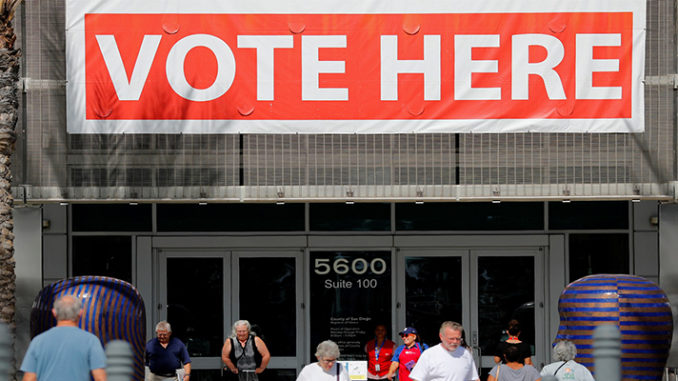
Dennis Baxley’s state Senate district in Florida is full of senior citizens with the time, talent and motivation to make a difference in politics.
“My constituents came here from small towns all over the country, and many of them had their own business or professions and still have a lot of energy for this next phase of life,” Baxley said. “They are very focused on preserving what they think of as American values, and very concerned that the country is turning into something other than the America they know and love.”
Areas like Baxley’s district, home to the sprawling The Villages retirement community south of Gainesville, could get more in-state political power if Florida decides to use voting-age citizens as the basis for drawing districts, rather than total population, including children and immigrants who aren’t citizens.
Although the U.S. Constitution is clear that congressional seats must be apportioned to states by population, states have been free to make their own decisions on drawing legislative districts.
As a result, conservatives repeatedly have floated the idea of drawing state legislative districts based on the number of voting-age citizens. The theory is that doing so would counteract the growing power of liberal cities that draw large number of immigrants, some living in the country illegally, in red states such as Texas and Florida.
The prospect of Republican gains helped prompt the Trump administration’s proposal to add a citizenship question to the 2020 U.S. census.
The idea suffered a setback Thursday when the Supreme Court said it wouldn’t allow the question to be added without further justification by the Commerce Department, which oversees the census. That will at least delay implementation, at a time when the department had expected to print forms by the end of the month. President Donald Trump tweeted that he wanted to delay the entire census until the question gets approved.
Many conservative districts like Baxley’s would benefit from the change in drawing districts, according to a Stateline analysis of American Community Survey data.
Of the 1,097 state senate districts nationwide that would benefit, 63% are in Republican hands.
Of the 811 that would suffer, 55% are Democratic. (The analysis excludes Vermont and West Virginia, which do not have single-member districts for the state senate.)
Drawing legislative districts based on adult citizens is an idea that has been broached in the predominantly red states of Alabama, Arizona, Kansas, Missouri, Nebraska, Tennessee and Texas. A 2015 U.S. Supreme Court ruling suggested it’s legal, given that Hawaii has long drawn districts according to registered voter numbers because of the confusion caused by temporary armed forces personnel who count as residents but vote in their home states.
The unanimous decision in the 2016 Evenwel v. Abbott case, written by Justice Ruth Bader Ginsburg, noted that many states already exclude from redistricting counts some people who don’t vote, like prisoners or armed service personnel in temporary quarters, and that the court has traditionally “left the drawing of states’ political boundaries to the states.”
But the Stateline analysis shows that the idea, if implemented nationwide, also would help many affluent liberal areas across the country and hurt some rural and suburban Republican areas with immigrant workforces.
The political benefits to more rural, conservative areas with older populations like The Villages, a 55-and-over community with the largest citizen voting-age population of any Senate district in Florida, are obvious. The 12th Senate District, which includes The Villages, has few new immigrants or children.
Nationally, the legislative districts that would suffer most in terms of lost representation are diverse Democratic districts like Texas state Sen. Carol Alvarado’s in eastern Houston. Her district has the lowest voting-age citizen population in the state.
“Anytime you lose any level of representation it’s not going to be good for our city,” Alvarado said. “The people here are utilizing resources — they’re driving on the roads and paying into the tax system — so they need to be counted when it’s time to divvy up the resources.”
But Edward Blum, director of the conservative Project on Fair Representation based in Virginia, who assisted in the Evenwel case supporting redistricting by citizenship, said such redistricting is the fairest way even if either party could be hurt in specific cases.
“Regardless of the partisan outcomes,” he said, “using citizenship instead of total population in redistricting will further the goal of electoral equality.” Blum called Thursday’s Supreme Court ruling “perhaps only a temporary setback.”
In Kansas, where its then-Secretary of State Kris Kobach was part of the 2017 Trump administration discussions on the citizenship question, the most vulnerable district is a Republican one around Dodge City where immigrants have been drawn to jobs in meatpacking plants.
The state Senate district that stands to benefit most, with the largest voting-age citizen population, is a Democratic one centered on Kansas State University in Manhattan.
Tom Hawk, the Democratic state senator for the Manhattan area, said he considers the views of conservative farmers and those of military personnel at Fort Riley as much as he does the views of liberal-leaning university students and professors.
“I’m morally obligated to represent people who don’t vote and even people who don’t agree with me,” Hawk said.
In Florida, the state Senate district with the most to lose — around Hialeah, a city north of Miami known as a magnet for new Cuban immigrants — is Republican.
Overall, Democrats hold the state senate districts most likely to lose power in 36 states. But Democrats also hold the districts most likely to benefit in 35 states — mostly because those are liberal but expensive areas with relatively small populations of new immigrants and families, such as midtown Manhattan, New York; Portland, Oregon; and San Francisco.
States would be hard-pressed to make the change without the results from the census citizenship question, which would provide a detailed count of voting-age citizens to draw new state legislative districts in 2022.
In fact, newly discovered documents penned by a deceased Republican strategist suggest that such redistricting was a prime reason for adding the question.
Factoring out new immigrants and children in legislative districting “would clearly be a disadvantage to the Democrats” and “would be advantageous to Republicans and non-Hispanic whites” but would be impossible without a census question to provide the data, according to private papers of redistricting specialist Thomas Hofeller obtained by the American Civil Liberties Union.
Hofeller was discussing results of a 2015 study of Texas showing that high-immigrant, Democratic-leaning areas like Houston would lose state representation while low-immigrant, more solidly Republican rural areas in the north of the state would gain.
States and cities often have used their own ways of counting people to create local districts. Some states count students at out-of-state colleges as if they were still at home, for example, and several states have moved to count prisoners in their home communities, which often are in Democratic cities, instead of in the more conservative rural areas that host prisons.
“Districting by voting criteria makes it easier to gerrymander,” said Paul Edelman, a Vanderbilt University law professor who studies the issue. “At the same time, I can’t help but be troubled by the huge disparities in eligible voting populations [between districts]. It is hard to believe that the representative is not more influenced by the voting constituency than the total population.”
While some state lawmakers have discussed the idea of switching to a count based on adult citizens, few politicians have advocated the idea openly. That’s partly because they don’t want to give more ammunition to opponents of the citizenship question, and partly because the 2020 elections and census are of greater concern right now.
Florida’s state Sen. Baxley sits on a committee for state redistricting and has already been through two other redistricting fights in his political career. The idea that his district’s residents could benefit from the new way is “interesting,” he said, but any indication he or other Republicans are trying to help themselves could be used against them.
“Once you get court challenges then you can get into a situation where a judge is redrawing the map and listening to the opposition,” Baxley said. “You lose control of the process.”
The time to consider new methods is not right before a major presidential election like 2020, he added.
That’s a common attitude among conservatives considering the plan, said Blum, the director of the Project on Fair Representation.
“I have heard from GOP types that this is a fight for another day. Not now,” Blum said.
Tim Henderson covers demographics for Pew Trust’s Stateline.



